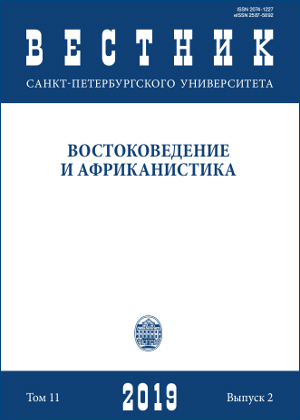A Semantic-Syntactical Aspect of the Subjunctive Mood in the Sacral Arabic Text (As Exemplified by the Surahs of the Koran)
DOI:
https://doi.org/10.21638/spbu13.2019.203Abstract
The subjunctive mood in the Arabic language is the object of study in this article, because it happens to be very frequent and spread in the explored text material. The subject of the analysis is semantic potential and syntactic functions of the verbal forms in the subjunctive mood. The purpose of the study is to clarify the specifics of performing syntactic functions by verbal units in the sacral text. In the course of the study, the authors come to the conclusion that the identification of specific semantic features in the Arabic verbal system as applied to the subjunctive mood is quite difficult and requires reference to the morphological and syntactic features of the verbal units that transmit the semantics of subjunctivity. This fact explains, among other things, the lack of linguists’ common point of view on the problem of identification and classification of forms of verbal moods. The subjunctive mood implements the tendency to polysemantics, which is explained by the complexity and multidimensionality of the semantic specificity of this grammatical category. The semantic-syntactical analysis of the Qur’anic sayings undertaken by the authors shows that the formation of the grammatical category of the subjunctive mood depends on the verb type, verbal inflections, the compatibility of the verb form with a particular syntactic particle and is accompanied by modifications of the semantics of the verb forms. The topological analysis of the Arabic sentence structure, containing subjunctive forms, reveals the presence of correlation between the frequency of subjunctive verbal forms and the type of subordinate sentence in the complex sentence.
Keywords:
religious discourse, Koran, sacral text, modality, subjunctive mood, semantic-syntactical aspect
Downloads
References
рр. 1–17.
Downloads
Published
How to Cite
Issue
Section
License
Articles of "Vestnik of Saint Petersburg University. Asian and African Studies" are open access distributed under the terms of the License Agreement with Saint Petersburg State University, which permits to the authors unrestricted distribution and self-archiving free of charge.





